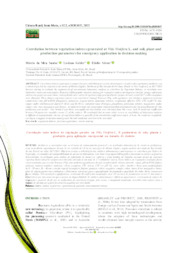Correlation between vegetation indexes generated at Vitis Vinifera L. and soil, plant and production parameters for emergency application in decision making.
Correlation between vegetation indexes generated at Vitis Vinifera L. and soil, plant and production parameters for emergency application in decision making.
Author(s): SANTOS, M. da S.; GEBLER, L.; SEBEM, E.
Summary: Correlation between proximal sensing techniques and laboratory results of qualitative variables plus agronomic attributes was evaluated of a 3,0 ha vineyard in the county of Muitos Capões, Northeast of Rio Grande do Sul State, Brazil, in Vitis vinifera L. at 2017/2018 harvest, aiming to evaluate the replacement of conventional laboratory analysis in viticulture by Vegetation Indexes, at situations were laboratory access are unavailable. Based on bibliographic research, looking for vegetative indexes developed or used for canopy reflectance analysis on grapevines and whose working bands were within the spectral range provided by the equipment used, a total of 17 viable candidates were obtained. These chosen vegetation indices were correlated, through Pearson (5%), with agronomic soil attributes (apparent electrical conductivity, clay, pH in H2O, phosphorus, potassium, organic matter, aluminum, calcium, magnesium, effective CTC, CTC at pH 7.0, zinc, copper, sulfur and boron) for depths 0 -20 cm and 20-40 cm, and plant tissue (Nitrogen, phosphorus, potassium, calcium, magnesium, sulfur, copper, zinc, iron, manganese and boron) , in addition to some key oenological and phytotechnical parameters for the quantification of wine production and quality. One hundred and thirty ninesignificant correlations were obtained from this cross, with 36 moderate coefficients between 19 parameter variables versus 12 of the indexes. We concluded that in cases where access or availability of laboratory analyzes is difficult or impracticable, the use of vegetation indices is possible if the correlation coefficients reach, at least, the moderate magnitude, serving as a support to decision making until the lack analytical structure to be remedied. Key words: vegetation indexes, precision agriculture, remote sensing
Publication year: 2022
Types of publication: Journal article
Unit: Embrapa Grape & Wine
Keywords: Precision agriculture, Remote sensing, Vegetation indexes
Observation
Some of Embrapa's publications are published as ePub files. To read them, use or download one of the following free software options to your computer or mobile device. Android: Google Play Books; IOS: iBooks; Windows and Linux: Calibre.
Access other publications
Access the Agricultural Research Database (BDPA) to consult Embrapa's full library collection and records.
Visit Embrapa Bookstore to purchase books and other publications sold by Embrapa.

